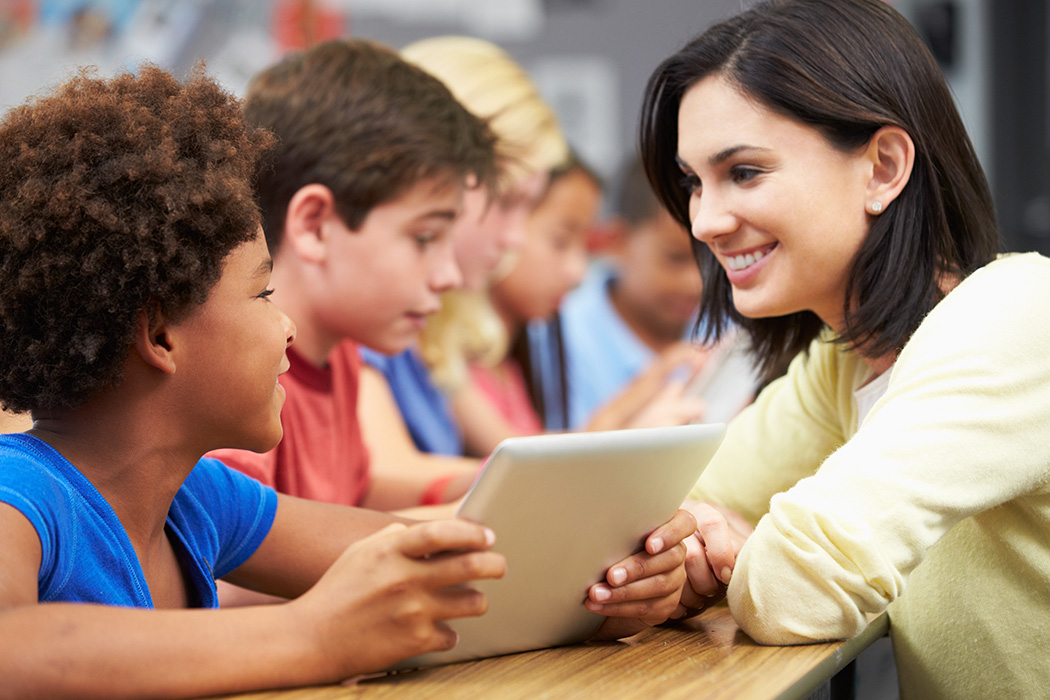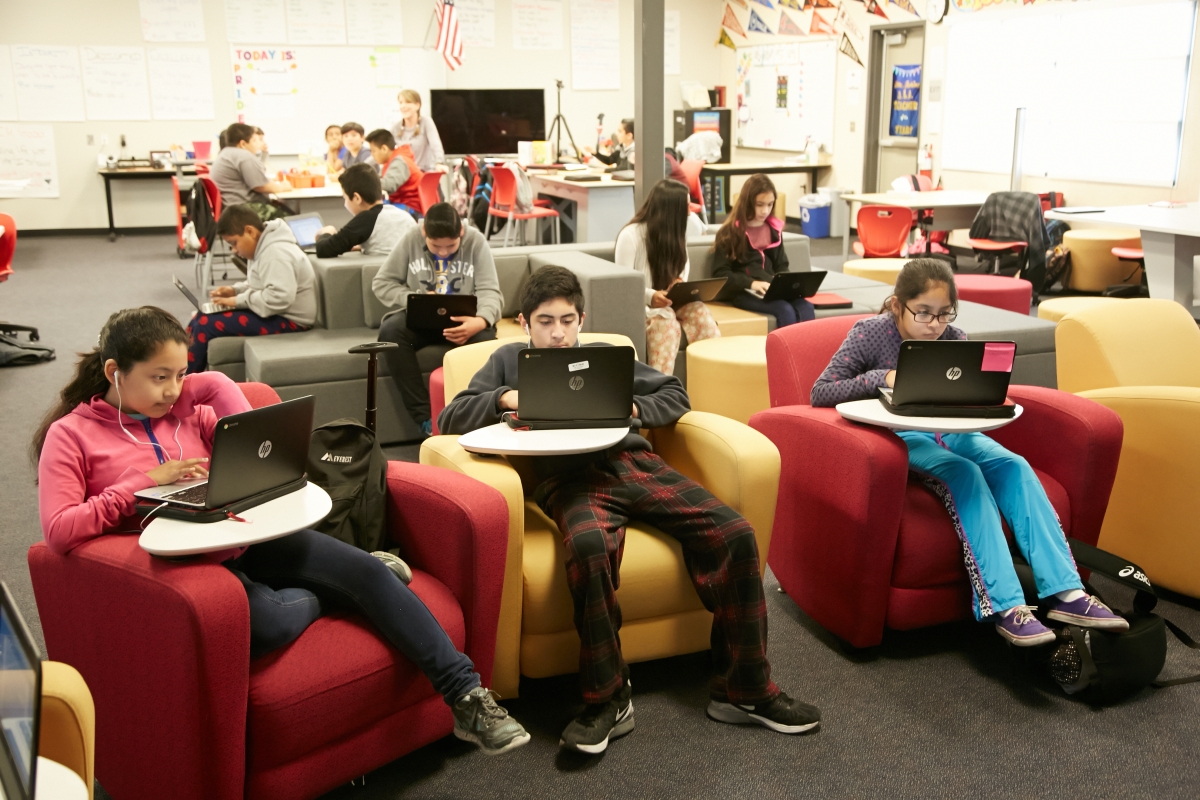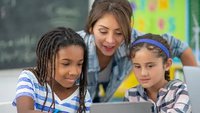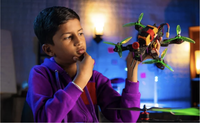The classroom structure of old was typically 30 desks or more facing forward for a predominantly whole group model. Theatre-style seating placed the teacher at the front-and-center of attention. With a new national focus on more individualized learning using software tactics, that model is soon to be seen only in old movies.
No longer the exclusive “source-point” of content, teachers instead are using software that today delivers the content while giving teachers a new freedom and function. They can now customize and curate for each student like never before. Not being the only source-point, teachers are finding they need more than a theatre-style room and may need no room at all for some of the learning. Other aspects of what is happening in the software are pushing the development of yet other special/environmental shifts.
Out with the Old
Lectures and students taking notes or learning as the teacher used the whiteboard or even, ewwww, chalk, allowed one efficiency. The teacher gave one lesson to all the students. The efficiency scale was all weighted on the side of the teacher, and only the most excellent in teaching skill were both delivering the lesson and watching with hawk-like vigilance for those moments when any one student got lost. If they were truly careful, at that moment of glaze-over for one student, the teacher was stopping to collect that lost student back into the fold or letting them drop behind.
In either case, at that particular point an inefficiency was entered. The saving of one sacrificed the time and attention of all the others who might have grown bored with the remediation. The not-saving of the one sacrificed the one, maybe forever. Lecturing is often the default for teachers unaware of new content delivery mechanisms, or the great breadth of the internet. Lecturing dictated the forum form of classrooms in the first place.
Textbooks had a certain structure and paced learning through chunks known as chapters. Each chapter typically had a formative assessment, a little test for understanding. Or there was an accompanying workbook for practice, depending on the subject being covered. Books could deliver ponderous amounts of information and plenty of nuance using the bridge of language. Another inefficiency was introduced by books – reading pace. Not every child in any one class reads at the exact same speed, so the same bifurcation would occur, some are bored, some are struggling to keep up. Discussion time generally fell back to lecturing time, so the structure of books tended to lend themselves to the existing form of the classroom and homework reading.
As a side note, mastery reading with book collections and novels tended to draw out readers to exercise their imaginations. This is because black-and-white words on a page expresses only a train-of-thought sentence-by-sentence. It does less “show” by picture. That alone is very instructive, and could be one of the things now showing up missing in the TV and video-game generations. There are schools that have mentioned to the Learning Counsel that they have had kids showing up that have never seen a book in recent years.
Videos and games convey a lot of the same things as books, but often do so at the expense of imagination, which is perhaps the one thing most needed today. These didn’t much change the classroom because they are just the addition of a large screen for whole-group viewing. They start to change the scene as the mobile-screen steps in, the laptop or tablet or smartphone. There is no doubt people learn from video and games, but the holy grail of learning things that are not easily story-formed such as all mathematics, is something that fits between the book and the full video or long-form game world. That something has come into being and is rapidly populating the learning landscape.
It’s “Screen Learning.” Not to be confused with online learning, which is defined very loosely as a course online that has guidance by a teacher and may have recorded lectures in it along with documents and instructions; or distance learning, which is even more loosely defined as learning across a distance from an instructor-led course. It’s also not “blended” or “personalized” or any of the other terms the industry has used to modify the existing classroom scene. 
Screen Learning is both in and outside the context of the classroom and teacher-learner paradigm.
Screen Learning is also both simpler and more complex than other terms related to imbuing education with tech.
It’s learning built for the computing screen, and that’s it. It doesn’t care where you are as a learner, or if a teacher is there, necessarily, although it doesn’t replace a teacher in every sense. It’s straight up built for the user. You know, like Microsoft’s Minecraft is built, marketed and sold to users. Kids learn elementary code concepts simply from using it.
Screen Learning is a content delivery mechanism, which a teacher has had as only one of many functions in the past. It usually combines reading but also video embedding and can get as deep as a full virtual world with interactivity of most of its elements. It could be built to talk to you, and be personalized by the student and sometimes individualized by the teacher so that the student view to lessons is narrowed or “gated” so that particular student gets a precise set of lessons. It may require certain teacher inputs and teacher creativity within the framework of its master conception.
Being built for the user is where Screen Learning is abruptly but subtly turning learning into the next big thing for commercialization. Because it also exactly matches the goals of customized learning so that every student gets exactly what they need, it’s also dovetailing into what institutions want to use but are not quite sure how to leverage in their current context.
Screen Learning and the Consumerization of Education
The most interesting thing about the burgeoning new world of Screen Learning is what it’s doing as a form and how fast it is propagating, which leads to a ripple effect in other aspects of education.
The problem is the uptake by schools has been too slow for the commercial world. Upon invention of these costly learning objects, publishers have had to try to earn in any way that they could. Many of the largest have been nearly gutted as non-spending of billions of dollars caused cutting of staff and resources.
What happened? In many instances, the talent cut simply went out and started new software companies, now using superior knowledge curation skill coupled with new programmers and software architects to build more start-ups for consumer products. In the meantime, schools almost universally went with their own teachers building home-grown learning objects, the vast majority of which are mere documents, links or recorded lectures. While these may be pedagogically useful, they aren’t necessarily meeting students with what they expect given all their other exposures to consumer-grade technologies.
In fairness, with the content world in fractured small bits, publishers weren’t ready for a while and no educational institution was structured to curate and sequence every one of thousands of standards plus build all the tests. The ordered and careful world of education fell to chaos and is still falling.
While the consumer world keeps gaining ground, and companies like ABCmouse with its billion-dollar market valuation, Leapfrog, PBS, History Channel, Disney, Amazon and others are suiting up for the coming take-over, teachers and schools using no Screen Learning, or no tech at all, are not only behind, most have no idea there could ever be a quantum shift.
And it’s already here.
Learning Remodeled: In 3 Stages
Screen Learning causes a needed remodeling of the physical environment. Schools are doing this by either remodeling their existing square-box classrooms or going for a whole-sale rip-out of walls and even roofs.
We like to think this is all going in stages:
Stage 1 – Arrival at an estimated 40% of classroom time as Screen Learning. The rest of the time probably needs to be spent on project-based-learning, good old whole-group, or labs. Teachers optimize their time while kids are in Screen to plan out the active collaborative time, while still eyeballing the kids to make sure no one is getting lost.
“We’ve pulled multiple different tools and programs into our classrooms to deliver screen learning with oversight from instructors which accomplishes a high level of engagement and real-time, real-world learning,” said Dr. Michelle Zimmerman from Renton Prep in Seattle. “We’ve used software from Florida Virtual Schools, ALEKS from McGraw Hill, Red Comet and Coursera and this gives the kids experience with all types of technical subjects and even experience dealing with live professors while still in high school. These tools are preparing our students for college and careers in ways we couldn't imagine even 5 years ago. As tools become more sophisticated, we'll continue to be able to more seamlessly merge the physical world with the digital in ways that still emphasize humanity.”
Sometimes, such as with the Dr. Zimmerman’s group, screen is more what has been called “blended,” a sort of use-the-tools while whole-group idea that is more consumer-oriented software tool use than it is content delivery. It may be content discovery as part of a whole group exercise. Arrival at such a robust coverage model is a long ways off for some schools.
Stage 2 – Remodeling the existing classrooms and spaces. This may mean new furniture and beanbags and video-conferencing table space and more. It may mean robotics labs with robot war rooms. It may mean video editing bays. There may be traffic-control boards just like you might see in an airport, telling kids what room they are in, and cubicles for solo work and libraries with project space.
Stage 3 – Rip and Replace or build new. This is where new concepts like “social-emotional spaces” and “quiet rooms” and “daylighting” come in. The future predicted by the Learning Counsel is a sort of “Expo” oriented learning center, a place that is shared but not totally compartmentalized, more like an exposition-of-learning that is high-engagement and high style. It is how schools will win students to attend when completely online education is an option nearly everywhere. Schools are already starting this, with floor-to-floor slides and fabulous cafeterias, commercial-grade professional software studios and maker-spaces.
Your mission, to explore the new world of learning spaces, to bravely go where school sustainability must inevitably go to synchronize with the rest of the economy in its experience orientation.
Excerpted from the Remodeling for Digital Curriculum special report, published by the Learning Counsel)











